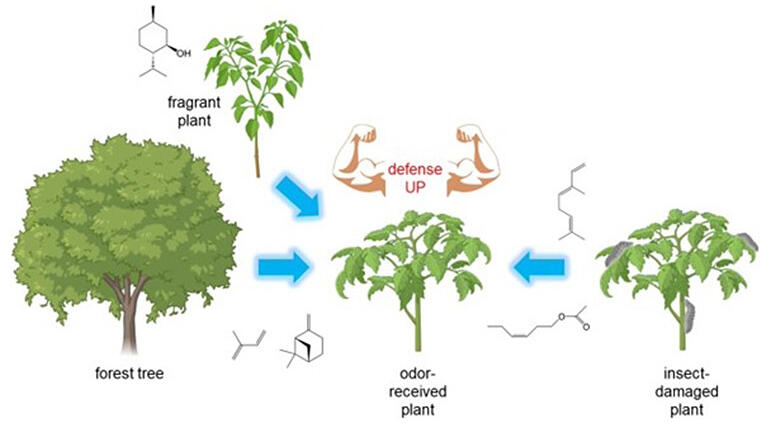Professor Gen-ichiro Arimura and Assistant Professor Takuya Uemura of the Department of Biological Science and Technology, Faculty of Advanced Engineering at Tokyo University of Science, have published a review article on their previous findings related to the action of odorants (volatile organic compounds [VOCs]) in plant−plant communication and the mechanisms by which plants sense VOCs. In agriculture and horticulture, new environmentally friendly technologies have been introduced. The technologies include companion plants (companion crops), which have positive effects on each other when grown close together, such as reducing feeding damage from phytophagous insects and supporting growth, and biostimulants (unlike pesticides and chemical fertilizers, substances that promote plant growth and tolerance to abiotic stresses from the environment). The results were published in the international journal Trends in Plant Science on October 11.

Provided by Tokyo University of Science
Plants are known to communicate with other organisms by exchanging VOCs. The scents emitted by flowers attract pollen-carrying insects such as butterflies and bees. The odors released from leaves eaten by phytophagous insects attract predaceous insects that are the natural enemies of the phytophagous insects. VOCs released by plants damaged by phytophagous insects have been observed to be transmitted to surrounding plants, in which they serve as triggers to enhance defense responses. Thus, VOCs have a major impact on the global environment and ecosystems. Terpenes, which are released from trees on the order of hundreds of teragrams annually, also have a noticeable impact on climate through the formation of aerosols.
Details of the research results:
- [1] Effects of VOCs on plants: VOCs are released when plant tissues are damaged and constantly emitted in large amounts from flowers and aromatic plants. Particularly, terpenes from a species can induce reactions in other species as well as closely related species.
- [2] Mechanisms by which plants recognize VOCs: Plants do not have olfactory organs like animals. However, they have unique molecular mechanisms to directly take up VOCs in mesophyll cells and elicit subsequent intracellular signaling.
- [3] Applications of plant−plant communication in agriculture and horticulture: Alternatives to using companion plants include treatment with low-cost essential oils.
Rose essential oil, which contains an abundance of β-citronellol, is a potent activator of the defensive properties of tomato leaves. To utilize these technologies, they should be tailored to increase efficiency and cost-effectiveness in the actual field.
Arimura said, "Dramatic progress has been made recently in elucidating plant−plant communication (talking plants) mechanisms by which odors emitted from plants enhance the defenses of neighboring plants. Furthermore, the foundations for utilizing this phenomenon in agriculture are being laid, and the future development and application of research in this field are expected worldwide."
Journal Information
Publication: Trends in Plant Science
Title: Cracking the plant VOC sensing code and its practical applications
DOI: 10.1016/j.tplants.2024.09.005
This article has been translated by JST with permission from The Science News Ltd. (https://sci-news.co.jp/). Unauthorized reproduction of the article and photographs is prohibited.




